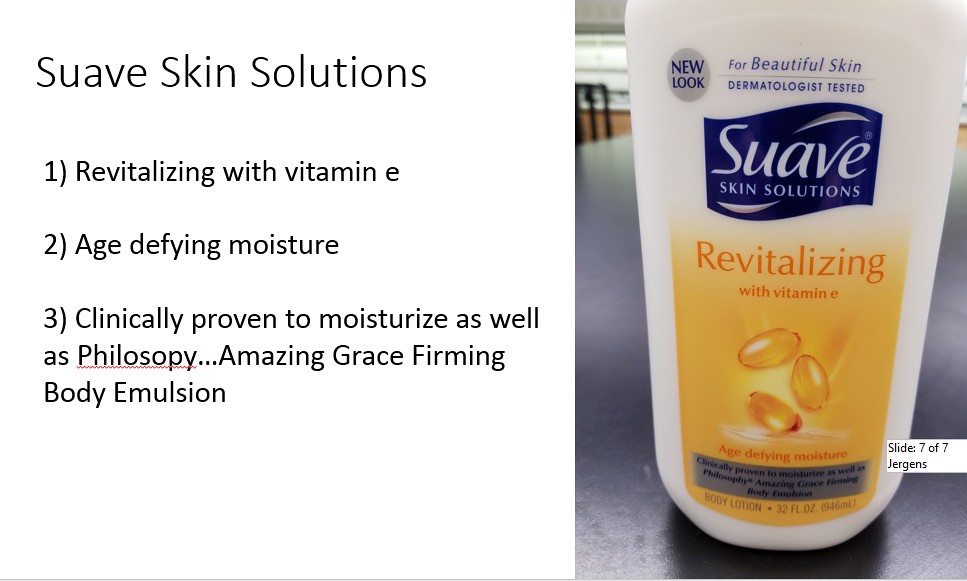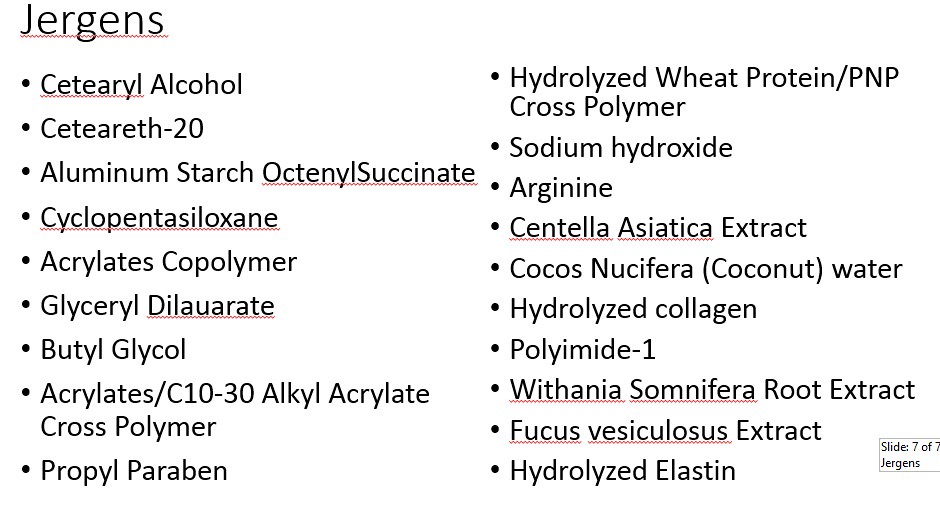With this in mind, we are continuing on with the last post. For those who have not read that post, there were two products (anti-aging skin creams) that were compared. One product was Jergens Skin Firming Moisturizing lotion. The second was Suave Skin Moisturizing lotion. Here are the two products shown below:
And ....
If you click on the name below the image, you will be directed to the original blog post which was written earlier on each product. Note that next to each picture of each product, there are bullet points which highlight the individual claims that are unique to each product. Additionally, you will remember that in the previous blog I highlighted the common ingredients (in list form) along with a list of the unique ingredients to each product.
The importance of these lists was to highlight the "common ingredients" along with the "unique" ingredients. In this blog post, I would like to discuss (somewhat briefly) the different ingredients and match them up to the individual claims.
Jergens Skin Firming Moisturizing Lotion:
To start with, take the first product Jergens Skin Firming Moisturizing Lotion. The ingredients which are unique to this product are shown below:
If we inspect the list above, the ingredients will support the claims of the product: 1) "tones and tightens skin" 2) "increases elasticity for visibly firmer skin" and 3) "with an illuminating Hydralucence blend and collagen and elastin".
The chemical acrylates copolymer will form a semi-solid film by combining with dimethicone. This could work as a "skin firming" agent to make the skin appear "tighter and firmer". Add to this mix the ingredients "hydrolyzed elastin" and "hydrolyzed collagen" to make up a layer with body. By "body" I mean that adding "hydrolyzed collagen" and holding the chemicals underneath the skin, there is a sense of "collagen restoration" to the skin -- making the skin appear to have more "body."
Remember that there are plenty of theories that collagen restoration is possible with various chemicals. Each pathway and process needs to be studied in more detail. Although, early suggestions is that chemicals such as 'vitamin D' is effective at restoration. The exact mechanism is not known. To substitute for the inability to generate 'collagen' which supports the skin's 'body' and "strength" -- different polymers and collagen are added with various chemicals. Wash the lotion off and return to your skin.
Now I should make a note: The polymer blend which provides a "skin" or "barrier" which makes the skin appear to be "firmer" also acts as a trap. "Hydrolyzed elastin" acts as a "humectant" which is retain water. In the process of absorbing water and trapping is underneath the "polymer film" the corneum layer is being hydrated and protected against damage.
As far as "anti-aging" properties, the moisturizing ability of this system is accomplished by the mechanism just discussed. Providing a barrier between your younger skin and the environment.
Suave - Skin Solutions:
Understanding how Jergens works will help us in understanding how the next product Suave Skin Solution lotion works too. The ingredients unique to this blend are shown below:
Remember the claims made by the product manufacturer: 1) "Revitalizing with vitamin E" 2) "Age defying moisture" and 3) "....Amazing grace firming body emulsion". The third claim is made by the composition of polymers added to the formulation.
"Carbomer" is a polymer which will form a layer or film with dimethicone and glyceryl stearate. Other ingredients such as glycol stearate and cetyl alcohol will act as a "stabilizer" or an "emulsifier" to the polymers which are present. Cetyl Alcohol is a waxy crystalline substance which will help provide "body" to the formulation.
The first claim that involves the chemical 'vitamin E' is supported by removing 'free radicals'. Free radicals are formed when damage occurs to molecules making up your skin. The result is an unstable 'radical molecule' which will react readily with other molecules like DNA or skin molecules. During the interaction, the original molecules are altered and therefore cannot function regularly. Which is to say, the skin molecules are damaged and will be rendered useless -- hence part of the process of 'aging'.
The ingredient which is truly unique to this product and acts like an "anti-aging" component is the "Retinyl Palmitate". Here is the profile from the "Environmental Working Group" shown below:
Retinyl Palmitiate is dangerous for a few reasons. Notice that ratings on the scale above in the upper left hand corner. On the right hand corner, the scale is from 0-10, with retinyl palmitate coming in at 9 -- not great.
The main danger is that the ingredient promotes 'cell division' which results in accelerated 'aging'. In the short term, the 'accelerated aging' appears to be restoring "younger skin" to the surface. Although, if you were to think of the skin cells making up skin as having 'a finite' number of 'cell divisions' over the course of your lifetime, you would realize the danger. If you keep regenerating skin to look healthy, eventually, you will have no defense system against UV radiation and other environmental damage that is done to the outer layer of your skin.
The last claim that I would like to discuss is the "age defying moisturizer" which is accomplished through 'trapping' moisture inside of the skin. This is accomplished with the chemicals which act like a "humectant" and "emollient" along with the polymers which form the film on the layer of your skin.
Conclusion:
In closing, this has been a short comparison of the unique chemicals to each formulation. Over time with other products added to the blog post, the ingredients will become more apparent. At this stage, the most important realization is that skin is best protected by reducing the environmental exposure during the day. Reduce the amount of sun exposure. Reduce the amount of 'dry weather' that your skin is exposed to. Hydrate your skin by applying a "moisturizer" to your skin. Protect your skin. That is the best 'anti-aging' treatment that you can provide at this moment.
Until next time, have a great day.





No comments:
Post a Comment